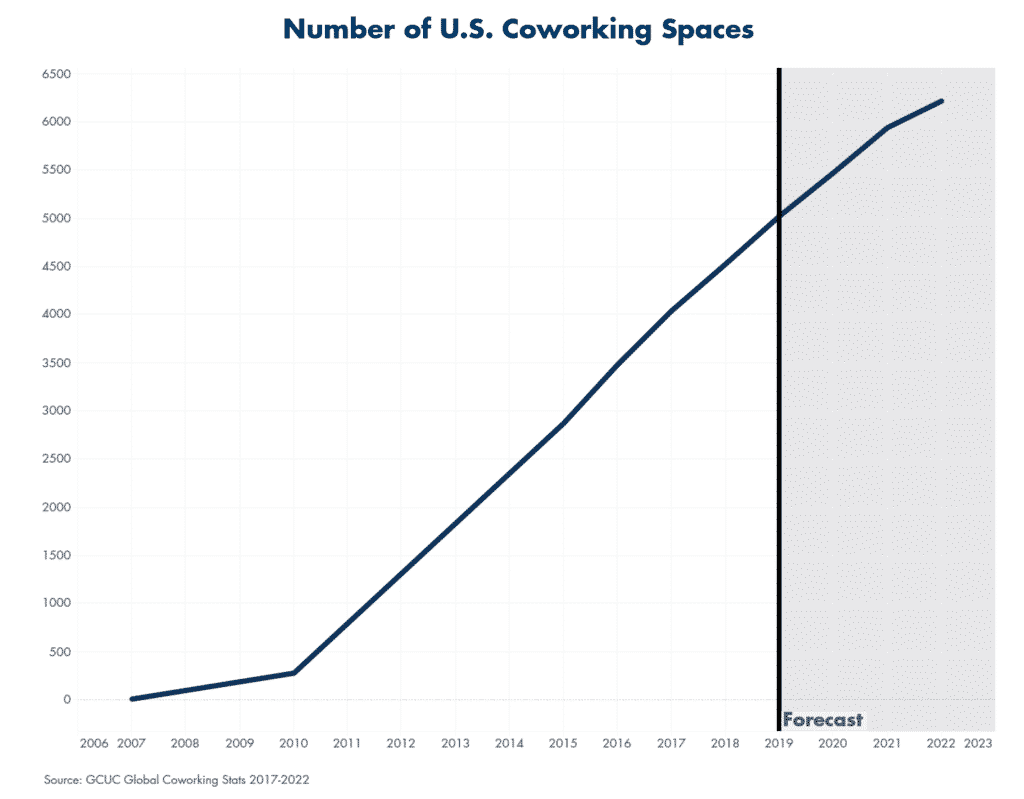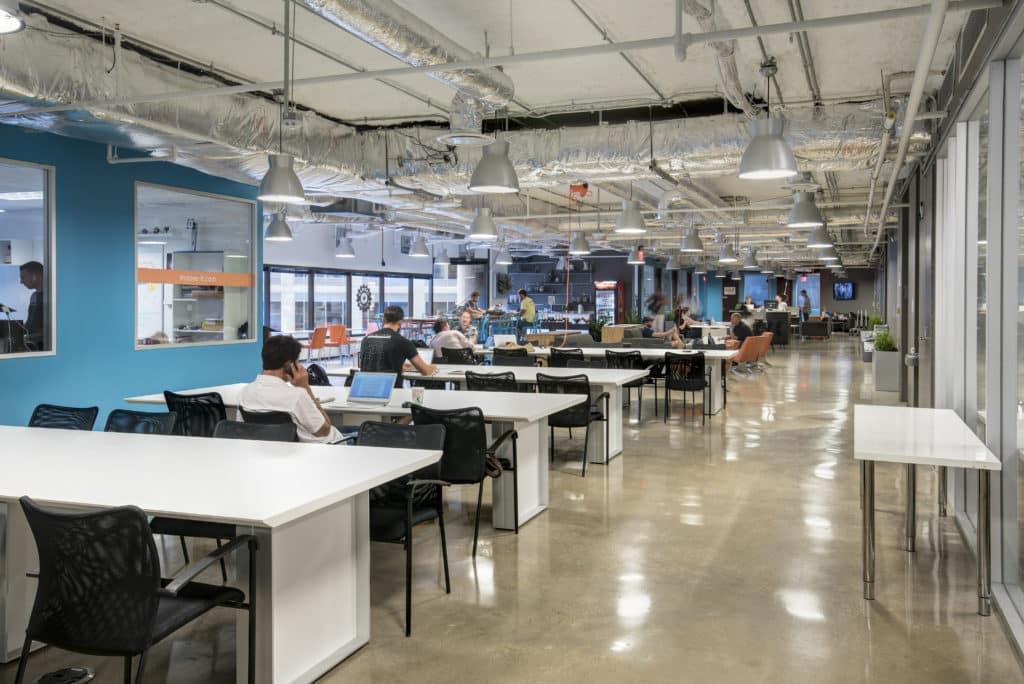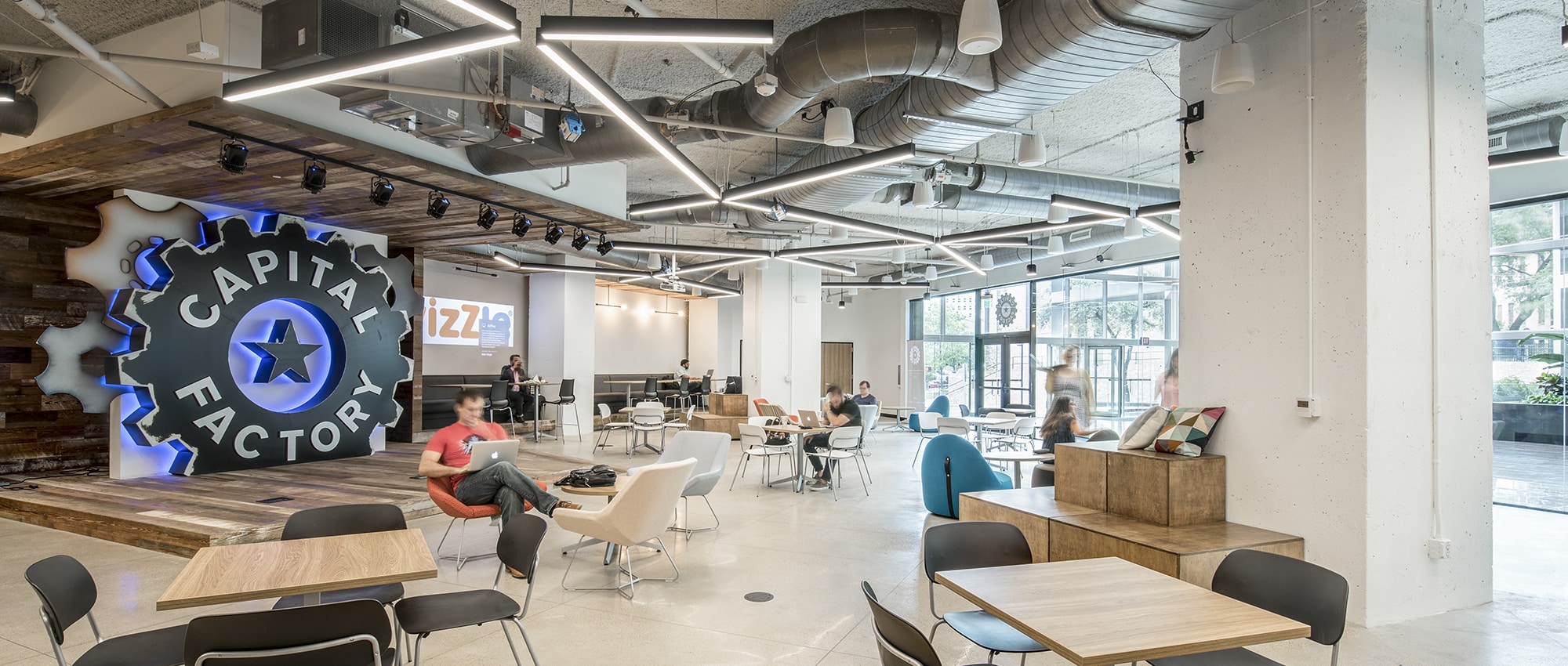This article was originally published in AQUILA’s 3Q 2018 Austin Office Market Report and will not be updated. Please contact us if you have specific questions regarding the information in this article.
Have you ever wondered where all the hopeful entrepreneurs, small business owners, and work-from-home employees in Austin go to work when they grow tired of going to the same mundane coffee shop (and drink too much caffeine in the process)?
For many (at least those in the “cool” cities like ours), coworking space has provided a much-needed resource to those who aren’t quite ready to lease an entire office but can’t bear the thought of spending one more day of work inside their apartment. Even enterprise users, from accounting firms all the way to Facebook and Microsoft, are finding value in coworking space as a way to offer a more flexible work environment.
Because coworking has become such a booming industry in Austin, we wanted to highlight a few of the most interesting facts and figures that we could lay our hands on.
In this article, we dig deep into the topic of coworking and cover:
- A brief overview of coworking
- The rise of coworking popularity in the United States
- A look at coworking in Austin, Texas
Whether you are sitting in the office or standing in line at your local taco truck, we hope you find this information as interesting as we did.
What is Coworking?
Before we can begin discussing coworking, we need to define exactly what it is. For our purposes, coworking is defined like this:
co•work•ing/kô’werking/ [noun]
|
||
Similar to the role internet cafes and coffee shops played in the 90s and early 2000s, coworking space provides a consistent and convenient place to work for people who do not fall under the traditional 9 – 5 office worker categorization. However, coworking takes this a step further by offering conference rooms, dedicated workstations, and all the amenities of a traditional office environment needed to work efficiently in today’s fast-paced world.
In essence, coworking provides a great answer to the question of where a person is supposed to work when the house or coffee shop simply isn’t enough.
The Rise of Coworking in the United States
Coworking is a fairly new industry but has expanded rapidly across the U.S. since the first locations began popping up around 2007. Whereas there were only 14 coworking spaces in the U.S. in 2007, today there are around 4,500, an average year-over-year growth rate of more than 20%. In fact, 55% of existing coworking spaces have been open for less than 5 years, and forecasts predict that this growth will continue for the foreseeable future.

And if you still have doubts about the extreme growth of coworking across the country, consider that, as of September 2018, WeWork is the largest office tenant in New York City, knocking JPMorgan Chase & Co. from the top spot. Accumulating 5.2 million sf over an eight-year period is no small feat, especially for an industry still in its infancy.
How Coworking Came to Be
The concept of leasing small amounts of space on a short-term basis is not new. The original version of coworking spaces were executive suites, commonly leased by small law firms and other professional service companies needing a place to receive mail and meet with clients.
As technology evolved over time and the internet became readily available to the masses, the need for these types of spaces decreased. Employees could now work remotely from anywhere, telecommuting to a central office when needed, but mostly working independently from any “home base.” Moving to today, where e-commerce sales in the U.S. accounted for $446 billion in 2017, working outside of the traditional office model is not an uncommon occurrence.
Increase in the Public Vocabulary
Along with the growth of coworking as an industry came an increasing use of the term “coworking” in the public lexicon.
Using Google Trends, which tracks the frequency of terms being searched through Google’s search engine, we can see that searches using the term “coworking” tracked very closely with the growth of these companies throughout the U.S. Values on the left of the chart indicate the popularity of the term over a given period, with 100 being the most popular and 50 being half as popular.

Coworking Compared to Traditional Office
When discussing coworking, the question is often asked of how it compares to traditional office space. After all, the vast majority of office space in the U.S. is leased traditionally, so what are the benefits of coworking?
Coworking provides some interesting ways to utilize office space that are currently not possible under a traditional office format.
In 2018, the average coworking space in the U.S. had 93 members, 66 desks, and 8,975 square feet. Looking at those numbers from a density perspective, this amounts to an office density of 96.5 square feet per person. Considering the U.S. average office density in 2018 is 194 square feet, coworking companies are able to fit far more people in less space than traditional offices.
Read Now: How Office Density Trends Impact Commercial Building Design [Q & A with The Beck Group]
Coworking spaces capitalize on the fact that not all users will be in the space at the same time. Because of this, coworking companies can fit more members into fewer desks – 1.6 members per desk according to 2018 numbers. By utilizing space more efficiently, the argument could be made that coworking is best suited to highly- competitive, low-vacancy markets where density is a deciding factor in space requirements. Austin, in other words.

Coworking spaces capitalize on the fact that not all users will be in the space at the same time. Because of this, coworking companies can fit more members into fewer desks.
Coworking in Austin, Texas
Coworking companies have not been shy about moving into Austin, and Austinites have accepted them with open arms. In a market with vacancy rates for Class A office space rarely going above 10% and full-service rental rates continually trending upwards, there is an increasing market for these types of spaces in Austin.
Top Coworking Companies in Austin, Texas
Today, Austin is home to about 720,000 square feet of coworking space. The majority of this space is attributable to WeWork, with most of the rest attributable to the four other top companies. Spread primarily between the CBD and The Domain, these five companies have given Austin’s countless tech entrepreneurs and start-up hopefuls a way to be immersed in two of the strongest office markets in Austin.

Average Prices of Coworking Space in Austin, Texas
Prices for the various types of coworking space in Austin are comparable to prices in other major cities, trending slightly on the higher end.
To calculate these averages, we used WeWork’s publicized pricing numbers because they are the dominant company in the U.S. and to maintain consistency across each usage type (other companies have different options that would be challenging to compare). Prices will also vary between locations in the same city.
| WeWork Monthly Prices in Major U.S. Cities | |||
| Location | Hot Desk | Dedicated Desk | Private Office |
| Austin | $410 | $500 | $900 |
| New York City | $500 | $700 | $1,200 |
| Boston | $400 | $480 | $750 |
| Chicago | $400 | $475 | $750 |
| Seattle | $340 | $450 | $650 |
| Portland | $300 | $450 | $600 |
| Average | $392 | $509 | $808 |
Source: WeWork
In WeWork’s case, “hot desks” give you access to any available desk in the common area of the WeWork location of your choice. These desks require you to bring your equipment each time you visit and allow you to book a desk at any other WeWork location for $50 per day.
A “dedicated desk” is a designated desk in a shared office that you are able to return to each time you visit.
A “private office” is the most premium option, which includes space of your own. These offices can accommodate teams of one to 100 plus.
While this pricing is obviously more expensive than working from home, it is still significantly cheaper than leasing space in a traditional manner and also gives access to amenities that were historically not accessible to people outside the traditional office environment.
Conclusion
Coworking is another player in the new “sharing economy” that has quickly made a place for itself in the city we call home (along with Uber and those love them/hate them scooters). As technology advances and businesses evolve, it will be interesting to see how companies begin to incorporate coworking into their strategy and how traditional office space will continue to compete.
To learn more about the state of the market in 1Q 2018, download your free copy of AQUILA’s comprehensive, Austin Office Market Report.

Popular Articles:
- How Office Density Trends Impact Commercial Building Design [Q & A with The Beck Group]
- Why Austin, Texas is a Best Place to Live & Work (as Ranked in US News, Forbes)
- Coworking: What is it, and What Does it Mean for Commercial Real Estate Brokers?

1Google Trends









